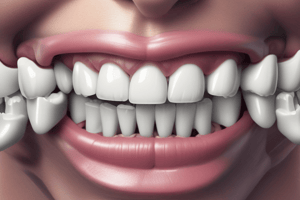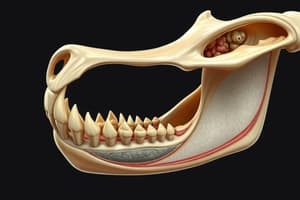Podcast
Questions and Answers
What is the condylar process connected to?
What is the condylar process connected to?
- Maxilla
- Zygoma
- Mandible (correct)
- Cranium
What type of bone is the condylar process a part of?
What type of bone is the condylar process a part of?
- Short bone (correct)
- Long bone
- Irregular bone
- Flat bone
What is the function of the condylar process?
What is the function of the condylar process?
- Protection of the brain
- Formation of the temporomandibular joint (correct)
- Support of the eyeball
- Attachment of muscles for jaw movement
What is the relationship between the condylar process and the mandible?
What is the relationship between the condylar process and the mandible?
What is the name of the joint formed by the condylar process and the mandible?
What is the name of the joint formed by the condylar process and the mandible?
What is the purpose of the temporomandibular joint?
What is the purpose of the temporomandibular joint?
What is the term for the direction towards the head in vertebrate anatomy?
What is the term for the direction towards the head in vertebrate anatomy?
Which term is used to describe the direction away from the head in vertebrate anatomy?
Which term is used to describe the direction away from the head in vertebrate anatomy?
What is the name of the section of the vertebrate body between the cranium and the caudal region?
What is the name of the section of the vertebrate body between the cranium and the caudal region?
Which of the following is NOT a directional term in vertebrate anatomy?
Which of the following is NOT a directional term in vertebrate anatomy?
What is the term for the study of the structure and organization of the brain?
What is the term for the study of the structure and organization of the brain?
Which of the following terms is used to describe the skull and its contents?
Which of the following terms is used to describe the skull and its contents?
What is the term for the study of the shape and size of the skull?
What is the term for the study of the shape and size of the skull?
Which of the following is a term used to describe the back of the head?
Which of the following is a term used to describe the back of the head?
What type of bones are found in the heterotropic bones?
What type of bones are found in the heterotropic bones?
Which of the following animals has a fully ossified hyoid apparatus?
Which of the following animals has a fully ossified hyoid apparatus?
What is the function of the thyrohyoid bone in the hyoid apparatus?
What is the function of the thyrohyoid bone in the hyoid apparatus?
Which bone is absent in ruminants?
Which bone is absent in ruminants?
What is the ligament that connects the hyoid bone to the basihyoid bone in pigs?
What is the ligament that connects the hyoid bone to the basihyoid bone in pigs?
Which of the following is NOT a characteristic of the hyoid apparatus in ruminants?
Which of the following is NOT a characteristic of the hyoid apparatus in ruminants?
What is the function of the stylohyoid bone?
What is the function of the stylohyoid bone?
Which of the following bones is NOT part of the lyoid apparatus?
Which of the following bones is NOT part of the lyoid apparatus?
Study Notes
Angular Process of the Mandible
- The angular process is a part of the condylar process in the mandible bone
- In bovines, the angular process is large and separate from the condylar process
- In pigs, the angular process is short and fused with the condylar process
Heterotropic Bones
- Heterotropic bones are bones that develop from a different type of tissue than the surrounding bones
- Examples of heterotropic bones include the os penis, os clitoridis, os cordis, and os kymina
- These bones are found in some mammals, but not in ruminants
Hyoid Apparatus
- The hyoid apparatus consists of the stylohyoid bone, epihyoid bone, and basihyoid bone
- In ruminants, the basihyoid bone is absent or fused with the stylohyoid bone
- In pigs, the ligamentum episthyoidea is not ossified
Cranial and Caudal Directions
- Cranial refers to the direction towards the head
- Caudal refers to the direction towards the tail
Studying That Suits You
Use AI to generate personalized quizzes and flashcards to suit your learning preferences.
Related Documents
Description
This quiz covers the angular process in condylar resorption, including its relation to the covonoid process and other anatomical structures.




